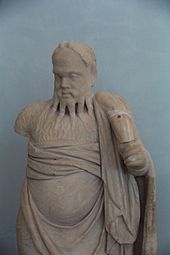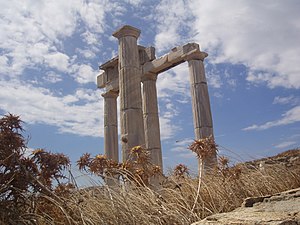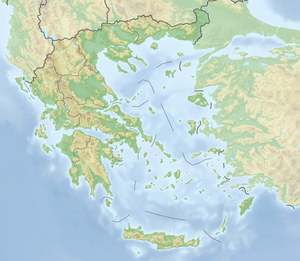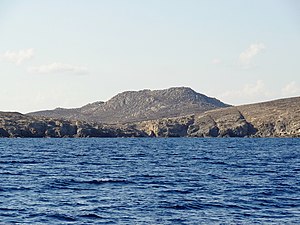Delos
| Delos | ||
|---|---|---|
| Ruins on Delos | ||
| Waters | Mediterranean Sea | |
| Archipelago | Cyclades | |
| Geographical location | 37 ° 23 '57 " N , 25 ° 15' 59" E | |
|
|
||
| length | 5 km | |
| width | 250 m | |
| surface | 3.536 km² | |
| Highest elevation | Kythnos (Kastro) 112 m |
|
| Residents | 24 (2011) 6.8 inhabitants / km² |
|
Delos ( ancient Greek Δῆλος , modern Greek Δήλος Dilos [ ˈðilɔs ] ( f. Sg. ), Also Mikra Dili 'Little Delos') is an island of the Cyclades in the Aegean Sea , located between Mykonos in the northeast and Rinia (ancient Rheneia ) in the west . It is a narrow, about 4.6 kilometers long and a maximum of 1.2 kilometers wide granite ridge with the mountain Kynthos in the middle (112 m). The area is 3.536 km². Today only the museum overseers live on Delos with their families.
Delos was a flourishing place in antiquity and, thanks to the local sanctuary of Apollo, it was a holy place for the Greeks.
The island was declared a World Heritage Site by UNESCO in 1990 .
myth
Once, as the myth tells, Delos was a floating island on the sea. Only here could Leto, persecuted by Hera and prevented from giving birth on any kind of solid ground, come down. Afterwards Poseidon (another version after Zeus ) attached the island to four diamond pillars.
Leto gave birth to Artemis and Apollon here (hence their nicknames Delia and Delios ).
"When you, ruler Apollo, there under the top of the palm tree, whom
she embraced with her arms, Leto, the honorable one, gave birth
to you of all immortal
beauties , there by the eye of the lake, the ambrosial scent of Delo's hallowed round was
filled up to the shore, and the fields around laughed
and the depths of the sea shone bluer with joy. "
The island was therefore a sacred place and became a main seat of worship for both deities after a pre-Greek pair of gods had been worshiped there.
King Anios , who led Aeneas to the oracle, is said to have lived on it at the time of Aeneas' wanderings . There Apollon announced to Aeneas that he should go to the "old mother". This was Italy, but Aeneas and his father Anchises misinterpreted it and they went to Crete.
history
Numerous temples and works of art adorned Delos; in particular, the magnificent temple of Apollo with the colossal statue of the god, a consecration gift from the Naxians , was considered the greatest sanctuary by all Greeks. It was a Doric building from the beginning of the 4th century BC. 29.49 m long and 13.55 m wide, as shown by the excavations carried out by Théophile Homolle for the French archaeological institute since 1877 .
To the north of this was an unusual altar made entirely of bull horns, the symbols of light, which gave rise to the so-called Delic problem .
All the Ionian states sent solemn embassies (theories) here with rich offerings, and immeasurable treasures piled up in the island's temples. There was also an oracle in Delos , which was considered to be one of the most reliable in its heyday, and every five years the famous Delian festival was celebrated there with singing, competitions and games of all kinds, in which all the tribes of Greece took part. Since Delos was, by virtue of its sanctity, a securely fenced off district, one of the largest Greek slave markets could also arise here , in the judgment of Michael Rostovtzeff even the “main slave market of the ancient world”, which even gained in importance with the rise of the Roman Empire .
The earliest inhabitants of the island are said to have been the Lelegs . From the early Bronze Age (3rd millennium BC) a small settlement was found on Mount Kynthos , which can be assigned to the Kastri culture . It was made around 2200 BC. Like all known settlements of the time. While other places as early as 2000 BC Were settled again, Delos was not settled until around 1400 BC. Inhabited again. A building complex and the remains of several other buildings from the Mycenaean period can be identified. Finds of jewelry and cult objects in the foundations under the later, ancient Artemision are remarkable. These are artistically engraved ivory plates, presumably of Cypriot origin, with depictions of warriors and wild animals that served as fittings for a wooden box, small bronze statuettes, two golden tiaras , other small golden figures, and a large number of spear and arrowheads. This small settlement was until about 1150 BC. Before the continuity of settlement broke off again and the so-called »dark centuries« began.
Around 900 BC The island was occupied by the Ionians . For a long time it was under its own priest-kings. In the 6th century BC The so-called 1st catharsis was carried out by Peisistratos : All graves were removed from the area around the temple. This religious rule of purity was introduced in 425 BC. Chr. In the so-called 2nd catharsis : Now all births, deaths and burials were forbidden on Delos, the graves were moved to the neighboring island of Rinia. According to Thucydides (I, VIII), the burials found in this way were identified as Carian because of the weapons and burial custom , probably wrongly. Delos was especially important as a center for the great Athenian alliance. Again as a result of the sanctity of the Temple of Apollo, from 477 BC The federal treasury is kept here.

454 BC Chr. The island was dependent on Athens , but enjoyed after the fall of this power by the Macedonians 336 v. Again relative freedom. Now the city of Delos, the ruins of which are north of those of the temple, flourished as an important trading center in the Aegean. In particular, it remained a popular slave market and, because of its duty-free status, next to the friendly Rhodes, it remained the center of traffic between the Black Sea and Alexandria . This traffic has been going on since the end of the 3rd century BC. Chr. By Ptolemäer promoted ascended to the protective power of the Aegean. Traded grain , wood , pitch and tar and probably silver . A kind of bank developed from the temple treasures, which grew steadily as a result of the pilgrims' offerings and from the income from the leasing of the temple's house and property , which issued loans against interest. The control of the trade, which extended to Numidia , was probably in the hands of outsiders; the inhabitants of the rapidly growing city, who were dependent on imports of all kinds, benefited little from it. So the temple had to issue bonds to the city of Delos itself.
From 166 BC Delos was a Roman protectorate , but was returned to Athens as a duty-free port and experienced its greatest economic heyday, especially after 146 BC. Chr. Corinth had been destroyed, and thus failed as a competitor. The inhabitants were deported from Athens to the Peloponnese to secure power and replaced by Athenians and Italians .
Delos became a center of expanding east-west trade between Asia Minor, Syria and Phenicia on the one hand and Italy on the other. It lost its character as a Greek city-state and became the business center of an international merchant community; Orientals and Egyptians also settled there and the temple lost its importance. Around 130 BC About 20,000 - 30,000 people lived here. The increasing Roman demand for agriculture- savvy oriental slaves and wars and anarchy in Syria led to the fact that since the end of the empire of Pergamon hardly Greeks, but Syrians, Bithynes , Cappadocians and others fell into slavery; the slave trade was now carried out by Roman Publicani by sea, with Delos as the main hub. According to Strabo , the island could take in and send tens of thousands of slaves every day; the favorable location on the east-west route through the Mediterranean made it possible for the Romans to meet their slave needs here without having to come into direct contact with the Cilician and Oriental slave traders.

A severe blow from which she never recovered hit the island, which even the Persians had spared, in the Mithridatic War . Menophanes , the general of Mithridates , landed in 87 BC. With a troop detachment near the open, unprotected city, murdered and sold the inhabitants, plundered and destroyed the city and the sanctuary with its numerous art treasures.
After the peace treaty in 84 BC Through Sulla , Delos came into the hands of the Romans, who later returned it to the Athenians. But in 69 BC The island was devastated again in the pirate war and has hardly been inhabited since then. In the 2nd century AD, only the guardians of the sanctuaries lived on Delos.
Of the splendid buildings of antiquity, only a few ruins of the Temple of Apollo, the theater and grammar school are left; Homolle's excavations uncovered those of the Letoon, Artemision, the Treasury, etc.
In early Christian times it came in the 2nd / 3rd Century to a repopulation, but with the new religion the island completely lost in importance and deserted.
On Kynthos , where the oldest Apollo shrine and, in Roman times, Egyptian places of worship were located, there are remains of a Frankish castle built from ancient ruins.
The town
The main temple of the city was that of Apollo, to which almost all other temples and buildings are based. The temple district in the center of the city dominates this and has repeatedly been expanded with additional temples. The main entrance to the temple precinct was in the south and has been used since the 2nd century BC. Adorned by a marble propylon. On the right is the house of the Naxians , which dates back to the 7th century BC. Was dated. There was also a kouros , the colossus of the Naxians made of Naxos marble and about nine meters high.
There were three temples in the center of the district. The northernmost was built by the Athenians in the 6th century. It is a poro temple, of which only the foundations are preserved today. The facade was adorned by six Ionic columns. The temple next to it was also consecrated by the Athenians. It dates from the year 417 BC. And is made of Pentelic marble . It is a building in the Doric order. The largest temple was the temple of the Delians , which was also built in the Doric order with 6 × 13 columns. It is a peripheral temple .
In Delos there are also the remains of a building that is likely to be the oldest surviving synagogue , which can also be verified as a building. The synagogue on Delos was excavated from 1912 to 1913 under the direction of André Plassart and dates in the preserved form to the second century BC (around 150 to 128 BC).
The surroundings of Delos
Even today it can be observed how the clear Greek light around the island does not show when more humid air currents flow in one or that direction and lead to the belief that several visible Cycladic islands are getting closer and further away, so that the old myth, Delos once swam on the water, which is quite plausible.
Next to Delos, across a strait that is only 0.6 km wide, lies the island of Rinia ("Great Delos"), which formed the burial place of Delos, since no one was born on the holy Delos, no one was allowed to die or find a grave. It consists of two jagged mountain masses that rise up to 150 m and are connected by a narrow isthmus ; it is 13.904 km² in size, even more barren and bare than Delos and like this is only visited from time to time by shepherds and boatmen.
geology
Delos can be structurally divided into three geological units, which are included in the metamorphic core complex of Mykonos :
- Paragneiss of the Cycladic Basement
- Transition zone
- Mykonos granite
The paragneiss can only be found on the north coast. By a transition zone with very low Ausstrichsbreite they are from 13.5 million years BP old ( Serravallian (again as Delos granite known) separated) Mykonos granite that about 90% of the island surface occupies. The paragneiss are weakly migmatitic metatexites, the leukosomes of which reach a maximum of 30 percent by volume. The melanosomes have a clearly pronounced planolinear structure (LS structure) on which the leukosomes are moved. The foliation of the paragneiss generally strikes east-northeast and falls mostly flat (up to a maximum of 40 °) to the south.
The approximately 100 meter wide transition zone also consists of paragneiss, but here they dip steeply to the south (by 70 °) and strike N 066. They are intruded by veins of fine-grain biotite-monzogranite . Your foliation shows close-knit folds both in the meter and millimeter range, the planes of which run more or less parallel to the foliation and the axes of which coincide with the stretched linear. Overall, the foliations form an anticline structure tilted slightly to the south . The linear dips only slightly in the direction of N 253.
The subsequent east-west trending granitoids are built up in layers, similar to those in the Mykonos Lakcolith. They can be divided into three petrological facies from north to south:
- Biotite monzogranite
- Monzogranite containing biotite and hornblende
- Pyroxene granodiorite
The granitoids show an intense magmatic deformation, which can be recognized by elongated feldspar phenocrystals. Their longitudinal axes are adjusted along a lineation dipping slightly to the east and lie in a steeply dipping foliation plane with a stroke direction varying from N 090 to N 045.
The biotite-monzogranite in the north forms a layered body that is only 30 meters thick, the contact of which with the mica schists of the transition zone is usually very sharp and runs parallel to their foliation. It can reappear within the biotite hornblende monzogranite in the center of the intrusion in centimeter-thick, steep to vertical layers. Often it also appears in the biotite-hornblende-monzogranite surrounded by veins carrying quartz-feldspar. As already mentioned, it can also appear as passages parallel to the foliation in the paragneiss. Further south, with sharp igneous contact, the biotite-hornblende-monzogranite with an outcrop width of one kilometer and the roughly uniform pyroxene-granodiorite follow . Both facies show subvertical foliations of magmatic origin and are therefore considered to be the root zone of the Lakkolite. The penetrating magma led to a steepening of the foliations in the paragneiss and, as already mentioned, to a more or less vertical fold of the contact zone. The resulting structure shows a clearly prolate ellipsoidal deformation in the root zone, caused by constricting (constrictive) deformation.
In the very south of Delos, the steep igneous root zone of the Lakkolite is finally left again and the more or less flat main body of the Lakkolite is touched, consisting of an alternation of pyroxene-granodiorite and biotite-hornblende-monzogranite. This main body then continues eastward on Mykonos, which it largely subordinates.
Web links
- Entry on the UNESCO World Heritage Center website ( English and French ).
- General information about Dilos, Aegean portal
Individual evidence
- ↑ Γενική Γραμματεία Εθνικής Στατιστικής Υπηρεσίας της Ελλάδος Γ.Γ.ΕΣΥΕ. [General Secretariat for Statistical Services of Greece] (Ed.): Concise Statistical Yearbook of Greece, 2009 . 2010, ISSN 1106-059X , p. 51 (Greek, English, viotiachamber.gr [PDF]).
- ^ Michael Rostovtzeff: Social and economic history of the Hellenistic world. Volume 1, Darmstadt 1998, p. 178 ff.
- ^ Strabo XIV 5.2.
- ^ Michael Rostovtzeff: Social and economic history of the Hellenistic world. Volume 2, Darmstadt 1998, pp. 624-629.
- ↑ Donald D. Binder: Delos (with numerous pictures, sketches and plans) pohick.org
- ^ Lee I. Levine: The Ancient Synagogue - The First Thousand Years. Edition 2. Yale University Press, 2005, p. 107 ff.
- ↑ Monika Trümper : The Oldest Original Synagogue Building in the Diaspora. The Delos Synagogue Reconsidered. In: Hesperia. Volume 73, No. 4 (Oct-Dec) 2004, pp. 513-598.
- ↑ Brichau, S. u. a .: Timing, slip rate, displacement and cooling history of the Mykonos detachment footwall, Cyclades, Greece, and implications for the opening of the Aegean Sea basin . In: Journal of the Geological Society of London . tape 165 , 2008, p. 263-277 .
- ↑ Lucas, I .: Le pluton de Mykonos-Delos-Rhenee (Cyclades, Grèce): un exemple de mise en place synchrone de l'extension crustale (doctoral thesis) . Orléans 1999, p. 491 .








